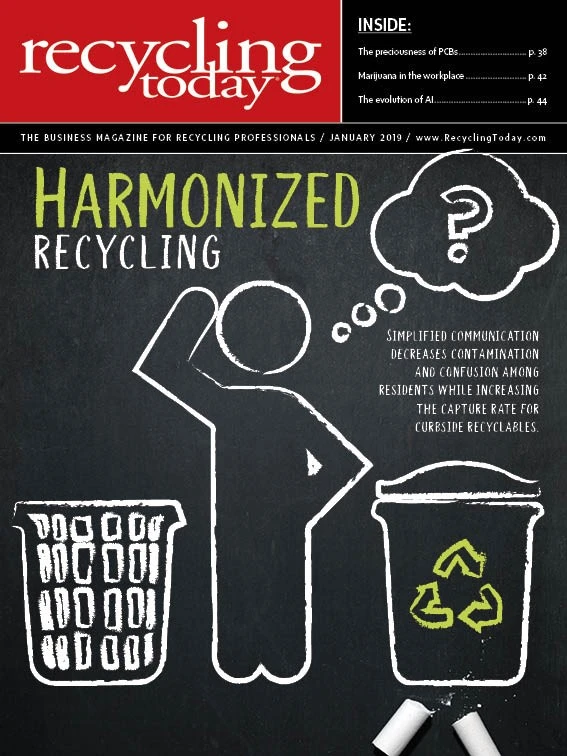Price stability and what appears to be a reasonable balance between global ferrous scrap supply and demand lasted into the December buying period, with domestic mill buying prices remaining largely unchanged from the month before.
A review of 2018’s Fastmarkets AMM ferrous scrap pricing shows the publication’s Midwest index price for prime grades never fell below $369 or rose above $403 per ton for the entire calendar year.
Scrap recyclers say they were pleased with the lack of price volatility in 2018, but they don’t take it for granted that the same climate will continue throughout 2019.
“Shredders seem to be allowing each other to make a living and have recaptured decent workable margins from the peddlers and dealers over the last two years.” – a Mid-Atlantic region recycler
“The year 2019 should start out strong; I feel good about the first quarter,” says a recycler based in the Mid-Atlantic region. “I do think the overall bull market and strong economy could start to peter out toward the second half of the year, especially if the tariff/trade war with China isn’t sorted out.”
With no geopolitical or U.S. economic events that could disrupt demand for steel or ferrous scrap, the recycler says, “Structurally, the scrap business is in good shape, especially the shredders, who seem to be allowing each other to make a living and have recaptured decent workable margins from the peddlers and dealers over the last two years.”

The recycler expresses equivalent optimism about the steel industry in the U.S., adding that domestic steel mill demand and margins seem to be very strong well into the coming year.
“If any infrastructure bills or money starts flowing, then the demand could remain for a much longer time,” the recycler adds.
In early December, a potential pause in upward momentum might have set in with the domestic steel sector, according to figures collected by the Washington-based American Iron and Steel Institute (AISI).
In the week ending Dec. 8, 2018, domestic raw steel output was 1.88 million tons, which was down 0.8 percent from the previous week’s total of 1.89 million tons.
Nonetheless, that week’s output (produced with a mill capacity rate of 80 percent) was 11.9 percent higher than the 1.68 million tons produced during the comparable week ending Dec. 8, 2017, when the mill capacity rate only registered 71.9 percent.
The AISI says 2018 year-to-date production through Dec. 8 was 89.4 million tons at a mill utilization rate of 78.2 percent. That is up 5.9 percent from the 84.45 million tons of output from the same period in 2017, when the mill capacity rate was 74 percent.
In the steel-intensive construction sector, construction employment nationally increased by 5,000 jobs in November 2018 and by 282,000 jobs during the previous 12 months, according to an analysis of new government data by the Associated General Contractors (AGC), based in Arlington, Virginia.
AGC Chief Economist Ken Simonson says, “Demand for construction remains strong and pay is rising faster than in the overall economy.”
The rising pay rates are needed to coax sufficient labor supply to join the sector, he adds.
Global steelmaking in 2018 also kept pace with output in 2017, according to figures collected by Brussels-based World Steel Association (WorldSteel).

Through the first 10 months of 2018, WorldSteel says global crude steel production for the 64 countries that report to it checked in at 1.50 billion metric tons, representing a 4.7 percent increase compared with the 1.43 billon metric tons of output in the first 10 months of 2017.
October did not demonstrate a slowdown, with the monthly output in 2018 surpassing output in October 2017 by 5.8 percent. While economists around the world have questioned the ability of China’s economy to keep consuming steel, China’s producers have not curtailed output.
In the first 10 months of 2018, Chinese mills boosted output by 6.4 percent compared with the first 10 months of 2017, and in October 2018 the nation’s output rose by 9.1 percent compared with October 2017.
The steel output increases through the first 10 months of 2018 were not nearly that high in several other nations that are leading buyers of exported U.S. ferrous scrap.
Turkey’s output rose by less than 1 percent in the first 10 months of 2018, while Taiwan’s output climbed by just 2.3 percent and South Korea’s production rose by just 2.2 percent.
The slow growth tempo in those major export markets may have been a factor in Fastmarkets AMM’s export price index drops in early December.
While its Midwest pricing was stable in December, its heavy melting steel (HMS) export price off the West Coast dropped by $22 per ton, or 6.7 percent, while the East Coast index dropped by $12 per ton, or 3.8 percent.
Get curated news on YOUR industry.
Enter your email to receive our newsletters.
Explore the January 2019 Issue
Check out more from this issue and find your next story to read.
Latest from Recycling Today
- ReMA opposes European efforts seeking export restrictions for recyclables
- Fresh Perspective: Raj Bagaria
- Saica announces plans for second US site
- Update: Novelis produces first aluminum coil made fully from recycled end-of-life automotive scrap
- Aimplas doubles online course offerings
- Radius to be acquired by Toyota subsidiary
- Algoma EAF to start in April
- Erema sees strong demand for high-volume PET systems






